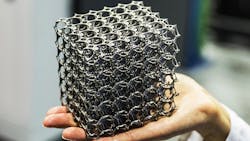Is This the 3-D Printing Breakthrough We've Been Waiting For?
There has been so much hype about 3-D printing over the last couple of years that it's practically impossible to find anyone unaware of the technology. We can now print anything from a chocolate cake to a house.
So why won't the deeply sceptical remarks stop popping up?
Well, let's be loving but honest - the problem with the lower-end FDM printers is that they aren't very good.
Someone who buys a printer for $350 and expects to print things of the same quality that an industrial printer can afford is probably going to be disappointed. These lower priced units are good for producing the very basic objects, but they're not a good case study to support the idea of 3-D printing revolution just yet.
The major objective for the low cost FDM manufacturers has always been to reduce the printing quality gap between their machines and the mid- and high-end line professional printers, and all while maintaining the affordability factor.
The unveiling of lower priced SLS 3-D printers means a massive stride towards the mass customization/personalization that 3-D printing was supposed to bring."
Recently the industry was given another injection of excitement when HP entered the market with their ground-breaking Multi Jet Fusion 3-D printing system, which, according to the company's claims, is 10 times faster than the next fastest printing process and the cheapest in its class. The interesting thing to note here is that HP promises to revolutionize the industry.
Can they keep their promise though? Econolyst has carried out an in-depth analysis of the HP printer, comparing it to other existing industrial processes, and arrived at the conclusion that, while the printer will disrupt some segments of the market, it won't necessarily turn the 3-D printing world upside down.
While HP has taken a major spotlight in the industry, another trend is rapidly emerging: Low cost SLS printers. Selective Laser Sintering (SLS) is the technology used in industrial grade 3-D printers.
It is used by 3-D printing services such as Shapeways and Sculpteo, and outperforms FDM printers in quality, accuracy and speed.
Over the past four months, several low cost SLS printers have been announced, and since the new generation of SLS machines is in line with financial capabilities of small businesses, the new trend seems promising.
But nothing changes over night, so let's see what the possible outcomes may be.
What Changes Can We Anticipate?
Thanks to the expiration of key patents in 2009, a real 3-D printing revolution was sparked: newly developed, affordable FDM desktop printers, priced as low as $300 per unit, hit the market within just a few years after that. That was something.
Given the fact that the main patents that prevented competition in the market for the most advanced 3-D printing technology - SLS - expired in February 2014, the hopes to see a similar effect have been high.
Everyone expected a full-on race, and it seems that we got what we wanted.
Laser sintering is the most functional 3-D printing technique, relying on a powerful laser that enables SLS machines to produce very high quality three-dimensional objects that can be sold as finished products.
Until now SLS printers were only accessible to companies with big bank accounts due to eye-watering costs, reaching as high as $1 million for a single machine.
Since February when the key patents expired, several companies jumped at the opportunity to announce either crowdfunded (Kickstarter & Indiegogo) campaigns to launch new generation, low-priced SLS printers, or fully developed machines ready to enter the market at a much more affordable rate.
What's Next?
Over the next few years, following the expiration of FDM patents in 2011, the prices of FDM printers dropped from several thousand dollars (~$14,000 five years ago) to hundreds - as low as $300, to be precise.
Undoubtedly, that had a dramatic impact on the development and expansion of 3-D printing industry and a major influence on shaping the maker movement as we see it now.
The biggest question now is whether the advent of lower priced, finally affordable SLS 3-D printers will cause a similar shift in the market.
The new generation SLS 3-D printers will soon be available at a fraction of the cost that's been offered before. And it's very likely the prices will keep dropping, as more machines enter the market, not to mention the opportunities that lie in the open source projects.
Because of the variety of materials, such as plastics, glass, ceramics and even metal (which is a related process known as direct metal laser sintering) that SLS machines can print the objects in and the high level of accuracy that's achieved with the help of a powerful laser, they're ideal for small businesses and manufacturers that need to create prototypes or detailed end products, design studios and existing 3-D printing hubs.
Designers or businesses that previously had to rely on the printing schedules of 3-D printing service companies such as 3-D Systems or Shapeways, could now be able to buy a new generation SLS 3-D printer and avoid shipping delays, and possibly even reduce the printing costs in the long run.
That leads us to a simple conclusion: More affordable SLS 3-D printers mean less business for the big players in the current market, increasing competition as new printing services set up and an improved turnaround times for end products.
In general, the unveiling of lower priced SLS 3-D printers means a massive stride towards the mass customization/personalization that 3-D printing was supposed to bring, as the process of going from an idea to a finished, high quality product in a matter of hours becomes a reality and even smaller design studios can do it.
On the other hand, what might slow the growth of SLS market is the complexity of the process: It's a much more difficult technology to handle comparing to FDM and it won't be a simple two-weeks learning process for the average entrepreneur. It requires detailed knowledge and skill to ensure the final product matches the expectations, as even a small change in temperature can mean a lot.
It must be said that there are some serious material handling and safety issues surrounding the SLS that are likely to prevent this type of printers from popping up in hobbyists' homes and garages anytime soon, so there is no real risk just yet that SLS 3-D printers can replace the conventional FDM or SLA technologies.
As more companies are ready to make investments, there is a chance that we'll soon see both prices of SLS 3-D printers plummeting to a more affordable level and further innovations in SLS driving the adoption of technology at a broader spectrum of businesses.
We can also anticipate to see new suitable materials invented and a growing competition in that segment of the market.
All in all, it is safe to conclude that low cost SLS printers will be the industry's hot topic in 2015 and some major new developments in 3-D printing industry are on the way.
Juste Semetaite, is the community and content manager at CGTrader.com, a community and marketplace for over 120,000 3-D graphics and 3-D printing specialists.


